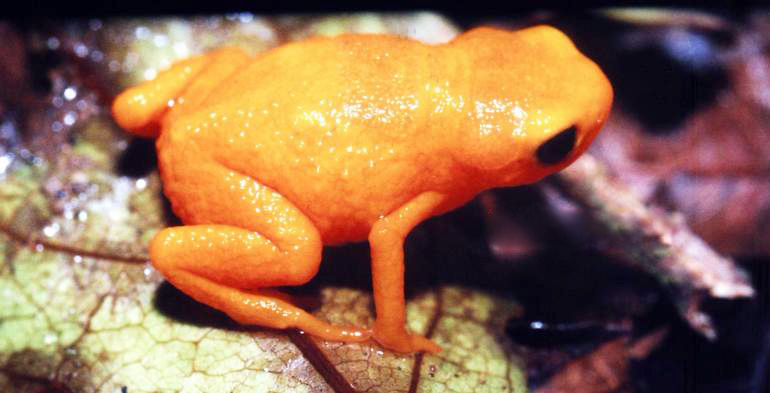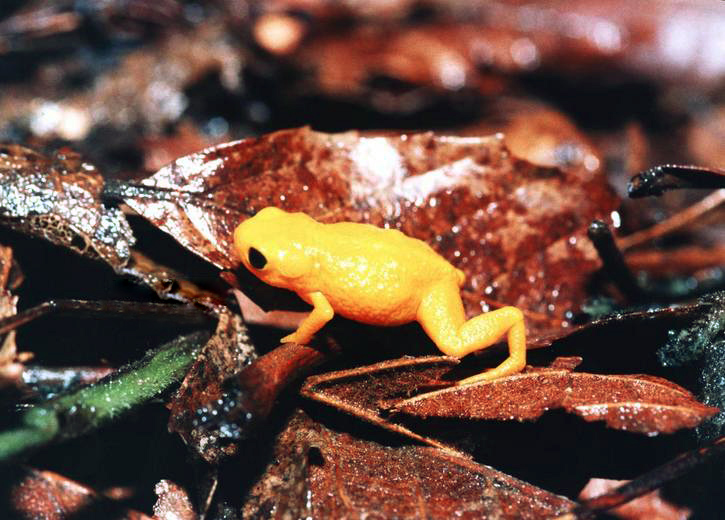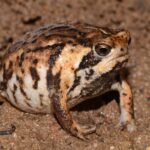Brachycephalus ephippium: The Astonishing World of Brazil’s Pumpkin Toadlet#
Nestled within the leaf litter and the mist-covered peaks of Brazil’s Atlantic Forest, a brilliant burst of color occasionally breaches an otherwise muted landscape of browns and greens. Upon closer inspection, this vivid splash reveals itself not as a fallen orchid or tropical fruit but as one of Earth’s most extraordinary amphibians—Brachycephalus ephippium, more charmingly known as the pumpkin toadlet.
This diminutive frog species, measuring no more than a thumbnail, carries within its petite frame a fascinating ecological narrative, striking adaptations, and considerable scientific curiosity. While its stature might seem inconsequential, its bright-orange body and unique behaviors have captured the imagination of naturalists, biologists, and conservationists alike. Why is this frog colored like a ripe pumpkin, and why does it walk rather than leap when startled? Beneath these intriguing questions lies a profound story of adaptation, evolution, and ecological importance.
Taxonomy and Classification#
Brachycephalus ephippium belongs to the family Brachycephalidae, which encompasses an incredibly diverse array of tiny, brightly-colored frogs endemic to Brazil. Within the genus Brachycephalus, all species are characterized by their diminutive size and often vividly bright warning colors signaling toxicity. First described scientifically in 1824, Brachycephalus ephippium was initially noted for its unusual appearance—the stark coloration and strangely shaped, flattened backbone from which the species derives the common name “Saddleback Toad” or “Pumpkin Toadlet.”
Close relatives within the genus demonstrate similar patterns, and collectively these tiny amphibians intrigue researchers due to their convergent traits linked to miniaturization. The genus itself is undergoing dynamic classification revisions, as new species continue being discovered within the Brazilian rainforests, underscoring the importance of conservation and further study in these rich habitats.
Natural Habitat#
The Hidden Realms of Brazil’s Mata Atlântica#
The pumpkin toadlet thrives exclusively within the lush realm of Brazil’s Atlantic Rainforest, or Mata Atlântica—a biodiversity hotspot with remarkable species endemism. Moist, high-altitude montane forests shrouded in cloud cover best suit these amphibians, whose habitats range from sea levels up to elevations of 1,900 meters. Here, humidity remains consistently high, creating a prime ecological stage for the toadlets’ specific life-cycle requirements.
Unlike typical amphibians dependent on flowing streams or sizable bodies of freshwater, Brachycephalus ephippium favors leaf litter carpets, where moisture saturates decaying vegetation. This environment ensures adequate concealment from predators, access to prey, and optimal microclimate conditions necessary for skin respiration—critical for a species devoid of typical lungs.
Calmly navigating through fallen leaves, pumpkin toadlets embody their environment’s profound connection between moist soil, decaying organic matter, fungi, invertebrates, and the myriad ecological interactions that enable remarkable specialized adaptations.
Physical Characteristics#
A Colorful Warning in Miniature#
Unmistakable from any other inhabitants of their hidden realm, pumpkin toadlets are known for their intense orange hue, ranging from golden-yellow to deep pumpkin shades. Their vivid colors aren’t merely decorative; these bright pigments signal their potent neurotoxin content to would-be predators. Aposematic coloration, common across the animal kingdom (think poison dart frogs and monarch butterflies), signifies the presence of potent toxins, effectively training predators to avoid these colorful, yet dangerous prey.
Typically measuring less than two centimeters—the size akin to a human fingertip—their compact physique features shortened limbs, robust bodies, and a distinctively flattened dorsal surface, known as an “epiphium,” derived from Latin as “little saddle.” Their notable lack of typical amphibian features such as webbed toes and visible eardrums only adds mystery to their already peculiar anatomy.
Yet perhaps most compellingly, these frogs demonstrate ossification in their skin and select bones, creating a partial armor-like structure beneath their skin—a skeletal trait unusual among amphibians, profoundly influencing their mobility and defense.
Behavior and Life Cycle#
Curious Habits of Tiny Amphibians#
A pumpkin toadlet’s life might seem simplified and tranquil from afar, but its existence is rife with fascinating and complex behaviors adapted to its micro-habitat. Remarkably, these amphibians do not leap considerable distances like their larger cousins. Instead, they employ slow, deliberate walking motions—and occasionally clumsy hops—amongst leaf litter. When disturbed, they are renowned for their paradoxical defense strategy—they cease movement, relying solely upon their bright coloration and repellent toxins to deter predators from indulging their curiosity further.
Breeding and Reproductive Habits#
Interestingly, these frogs exhibit terrestrial breeding—meaning their entire reproductive cycle, from egg to froglet, transpires away from water sources entirely. Eggs laid by females are deposited in sheltered, moisture-rich leaf litter, meticulously tucked beneath fallen leaves or decaying logs. Direct development ensures frogs hatch as miniature replicas of adults, skipping the tadpole stage altogether.
During the reproductive season, males utilize remarkably high-pitched vocalizations, though curiously, recent studies suggest these distinctive calls might exceed the frog’s own hearing capabilities, raising questions about potentially unexplored communication mechanisms for these striking amphibians.
Ecological Role#
Though modest in size, the ecological impact of Brachycephalus ephippium should not be understated. They function as critical components in their ecosystem, consuming minute invertebrates such as mites and springtails, thus helping regulate micro-invertebrate populations. Their sensitive skin and niche habitat preferences also serve researchers as reliable bioindicator species, able to reflect shifts in local climate conditions, habitat degradation or forest health accurately.
Simultaneously prey and predator, these frogs’ defensive toxins deter predation by snakes, birds, and other amphibians, shaping predator-prey dynamics within their limited geographic distribution. Their drastic warning coloration, coupled with potent toxins, creates intricate predator-prey interactions, rippling through other species’ evolutionary strategies across the Atlantic rainforest understory.
Threats and Conservation Status#
The International Union for Conservation of Nature (IUCN) currently lists the pumpkin toadlet as Least Concern, highlighting its relatively stable population within adequately preserved and protected habitat segments. Yet, the future remains uncertain. The Atlantic Forest faces severe fragmentation and loss from human-driven activities—agricultural expansion, logging efforts, infrastructure development, invasive species introduction, and widespread deforestation.
Climate change further compounds risks, where subtle alterations in rainfall patterns, humidity, or forest coverage profoundly impact these delicate amphibians, given their vulnerable moisture dependency and micro-climatic requirements.
Conservation Efforts and Future Prospects#
Initiatives within Brazil, ranging from protected area establishment, habitat restoration projects, and stringent regulations to curb deforestation, represent critical steps in safeguarding the pumpkin toadlets’ habitats. Leveraging public appreciation for charismatic yet enigmatic species such as Brachycephalus ephippium, combined with scientific research highlighting these frogs’ critical roles, stands to reinforce conservation advocacy and sustain long-term preservation.
Cultural and Scientific Significance#
Interestingly, despite its obscurity in popular culture, the pumpkin toadlet holds significant scientific intrigue. Researchers pursue studies around its toxins, neurological adaptations, and sensory perception, particularly captivating the mystery surrounding its apparent inability to hear its own calls. These studies provide broader ecological insights into amphibian evolution, adaptive radiation, and miniature vertebrate physiology.
For indigenous communities and environmentalists, the mere presence of such an extraordinarily specialized species often fosters deeper cultural appreciation for protecting ancestral habitats. It highlights interconnectivity between humans and nature, emphasizing the profound benefits contained within preserving biodiversity hotspots such as the Atlantic Rainforest.
Conclusion#
The pumpkin toadlet, Brachycephalus ephippium, is far more than its minute size and curious behaviors initially convey. Within its compact, bright-colored form lies an intricate story of survival, adaptation, ecological interplay, and compelling biological enigmas waiting to be further understood.
As guardians of Earth’s biodiversity, it’s incumbent upon us to protect ecosystems like the Atlantic Forest, valuing creatures such as the pumpkin toadlet. Safeguarding these vibrant amphibians ensures the continued understanding and appreciation of nature’s magnificent complexity—an endeavor each one of us can champion through awareness, support, and collaboration in global conservation efforts.















